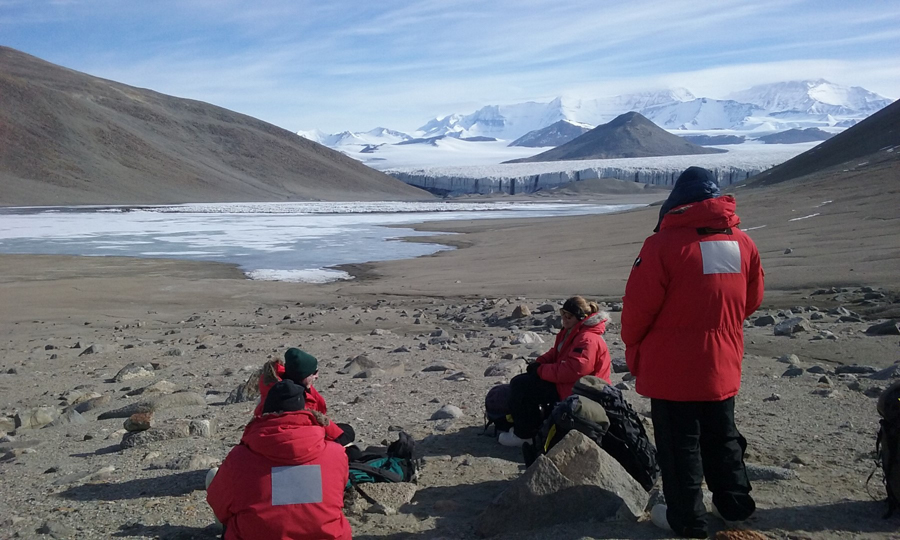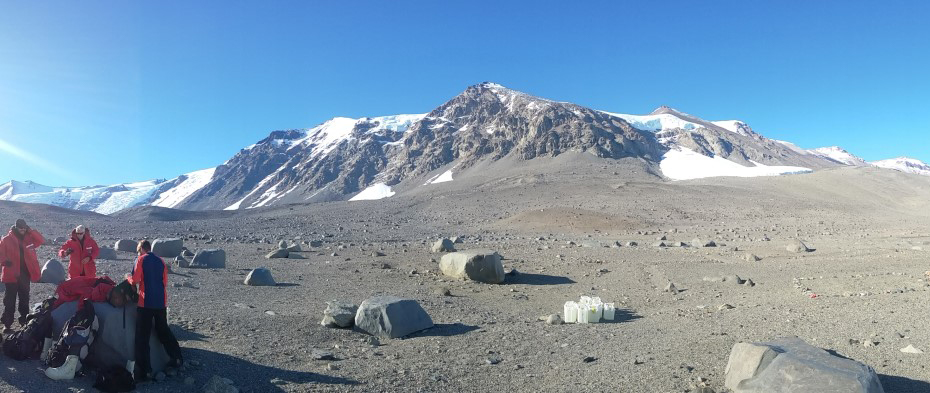Climate Change in the McMurdo Dry ValleysNumbers of the Most Abundant Creature in the Polar Desert are DecliningPosted April 24, 2018
The McMurdo Dry Valleys ecosystems are changing because of climate change. 
Photo Credit: Walter Andriuzzi
The nematode Scottnema lindsayae as it appears under the microscope. In reality, the small roundworm is about half as long as the period at the end of this sentence.
In a paper published in the journal Ecology in January researchers said they’ve tracked the decline of the dominant microorganism living in the Dry Valleys’ barren soils. More frequent extreme weather events are driving down the population of the nematode Scottnema lindsayae, a microscopic roundworm, which makes up about 90 percent of the species that live in the Dry Valleys. “We found that in the last few years, compared to the ‘90s, its abundance has declined quite strongly” said Walter Andriuzzi, a postdoctoral principal investigator in Diana Wall’s lab at Colorado State University and the lead author on the paper. “In some sites it declined by over 30 or 40 percent in abundance, which is quite a lot.” At the same time, other species that thrive in warmer, wetter conditions are not increasing at the expected rate needed to make up for the losses. “Scottnema lindsayae is declining much faster than the other species are increasing in abundance and so overall we have a decline in the number of soil invertebrates in the Dry Valleys,” Andriuzzi said. The research was funded by the National Science Foundation, which manages the U.S. Antarctic Program. The McMurdo Dry Valleys are the largest region of ice-free land in Antarctica. The region is extremely arid, with nearly no precipitation and what little water there is frozen in glaciers and permafrost for almost the entire year. Once thought to be completely sterile, more recent studies unveiled a small menagerie of hearty microbes eking out a living, often at the very edges of survival. 
Photo Credit: Walter Andriuzzi
The research team prepares to collect samples in the Garwood valley. From left to right: Andy Taylor, Ross Virginia, Ashley Shaw and Matt Hedin.
They’ve been the focus of researchers in the Long Term Ecological Research program since 1993 to understand the ecology of this unique environment. The soils team have been returning to the same sites in the Dry Valleys over the past two decades, taking soil samples and comparing the number of different species found at their sites. “This is the first time that we have a really long-term document of what’s happening in the field,” Andriuzzi said. The paper describes the prevalence of the microscopic nematode Scottnema lindsayae, the most abundant microorganism in the Dry Valleys by far. About half the size of the period at the end of this sentence, it feeds on microbes and bacteria and is specially adapted for life in the harsh Dry Valleys. They found that over the first years of the project, the populations were holding steady. This was during a period where there was a slight cooling trend in the Dry Valleys. Then in 2001, a relative heatwave passed through the region, and it was as if a switch was flipped. The region started to warm. More importantly the frequency of extreme weather events – sudden, short bursts of above-freezing temperatures – increased significantly, adding an unexpected stress on the nematode. Since then, their population has been on the decline. “We’re not sure exactly as to the mechanism, but definitely the data suggests the mortality of Scottnema lindsayae when there are these intense weather events,” Andriuzzi said. 
Photo Credit: Ashley Shaw
In order to reach their sampling sites in the Dry Valleys, the research team flew in helicopters from McMurdo Station.
One possibility is that the water is releasing salts that are dissolved into the soils. When the weather warms and the water flows, it could be releasing more of those salts and the nematode can’t handle the spike in salinity. Another possibility could be that the more “freeze-thaw cycles” a nematodes undergoes, the more stressed it gets. When conditions get harsh and water becomes scare, the nematode enters into kind of suspended animation until conditions improve, a process called anhydrobiosis. The nematode essentially dries itself out and goes dormant until water is available again when it wakes up. Now that these extreme weather events in the Dry Valleys are becoming more frequent, the nematodes go through this process more often. “Many of those nematodes will go right back into anhydrobiosis,” Andriuzzi said. “But some of them, maybe some individuals that have low metabolic reserves or whatever reason, they may not be able to do that, so they will die.” At the same time in the Dry Valleys, the other species of nematodes and other microorganisms like rotifers and tardigrades, are only starting to fill in the gaps in the ecosystem that the decline of Scottnema lindsayae is creating as it’s dying out. “The prediction was that overall as the Dry Valleys become warmer and wetter, the overall totals in the soil fauna abundance would increase, but were finding that’s not the case so far,” Andriuzzi said. He added that they are seeing other species moving into higher elevations and growing in abundance, but not at the rate that Scottnema lindsayae is declining. It’s not clear yet exactly what the impacts of the decline will be for the ecosystems in the Dry Valleys, but because Scottnema lindsayae is such a dominant species, it’s likely to be significant. “They’re very important in regulating microbial populations and the carbon cycling,” Andriuzzi said. “This means that there’s probably going to be… some potential important effects on the cycling of carbon and nutrients in the Dry Valleys. We’re not sure yet what the direction of change we can expect, we can definitely at least say probably something is happening.” The team will continue to monitor the sites and keep tabs on the populations of the Microorganisms in the Dry Valleys. NSF-funded research in this story: W. Berry Lyons of the Ohio State University, Award No. 0096250, and Michael Gooseff, University of Colorado, Boulder et. al Award No. 1115245. |
"News about the USAP, the Ice, and the People"



For USAP Participants |
For The Public |
For Researchers and EducatorsContact UsU.S. National Science FoundationOffice of Polar Programs Geosciences Directorate 2415 Eisenhower Avenue, Suite W7100 Alexandria, VA 22314 Sign up for the NSF Office of Polar Programs newsletter and events. Feedback Form |


